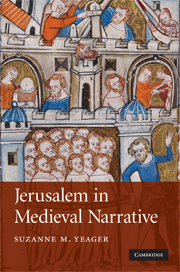Book contents
- Frontmatter
- Contents
- Acknowledgments
- List of abbreviations
- Introduction: texts and contexts
- 1 Pilgrimage to Jerusalem: three accounts by English authors
- 2 Craving heritage: portrayals of Richard I and the English quest for Jerusalem in Richard, Coer de Lyon
- 3 The crusade of the soul in The Siege of Jerusalem
- 4 The Book of Sir John Mandeville: text of pilgrimage and spiritual reform
- 5 Beyond the Celestial and Terrestrial Jerusalem: the Promised Land in western Christendom
- Conclusion
- Notes
- Bibliography
- Index
- CAMBRIDGE STUDIES IN MEDIEVAL LITERATURE
Introduction: texts and contexts
Published online by Cambridge University Press: 22 September 2009
- Frontmatter
- Contents
- Acknowledgments
- List of abbreviations
- Introduction: texts and contexts
- 1 Pilgrimage to Jerusalem: three accounts by English authors
- 2 Craving heritage: portrayals of Richard I and the English quest for Jerusalem in Richard, Coer de Lyon
- 3 The crusade of the soul in The Siege of Jerusalem
- 4 The Book of Sir John Mandeville: text of pilgrimage and spiritual reform
- 5 Beyond the Celestial and Terrestrial Jerusalem: the Promised Land in western Christendom
- Conclusion
- Notes
- Bibliography
- Index
- CAMBRIDGE STUDIES IN MEDIEVAL LITERATURE
Summary
O England great cause thou hast glad for to be
Compared to the Land of Promise, Sion,
Thou attainest grace to stand in that degree
Through this gracious Lady's supportacion,
To be called in every realm and region
The Holy Land, Our Lady's Dowry:
Thus art thou named of old antiquity.
–from the “Walsingham Ballad”Jerusalem has been represented for more than two millennia as a recurrent object of travelers' desire. Viewed as the cradle of three faiths – Christianity, Islam, and Judaism – the city serves simultaneously as the home of the Holy Sepulchre, the Dome of the Rock, and place of the Temple. In all cases the sacred city held and, for some, continues to hold value as the locus of scriptural and devotional imagination for the People of the Book. This study explores texts made by English medieval Christian writers who characterized the holy city in a multiplicity of ways. By the fourteenth century, English authors had, readily available to them, fully developed symbolic terms with which to describe Jerusalem. This terminology, enriched for over a millennium by figures such as Augustine, John Cassian, Gregory the Great, Bede, and many others, contributed to the theological refinement of the city's many senses. Likewise, in the hands of English, fourteenth-century writers, the holy city was like a palimpsest ready for inscription.
Information
- Type
- Chapter
- Information
- Jerusalem in Medieval Narrative , pp. 1 - 16Publisher: Cambridge University PressPrint publication year: 2008
